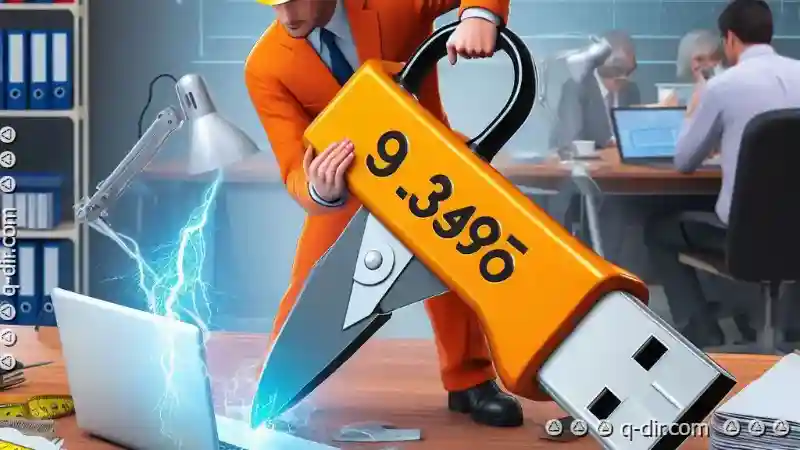Inserting a USB drive is one of the simplest yet most effective ways to transfer files between computers. Whether you're transferring large video files, ...
 important project documents, or simply moving data from an old computer to a new one, USB drives are incredibly handy. However, as straightforward as this process may seem, issues can arise during the cutting (copying) of files to a USB drive. In this blog post, we will explore some common problems that you might encounter when transferring files to a USB drive and how to resolve them.
important project documents, or simply moving data from an old computer to a new one, USB drives are incredibly handy. However, as straightforward as this process may seem, issues can arise during the cutting (copying) of files to a USB drive. In this blog post, we will explore some common problems that you might encounter when transferring files to a USB drive and how to resolve them.1. Sub-points on Cutting Files to a USB Drive: Potential Issues
2. Conclusion
1.) Sub-points on Cutting Files to a USB Drive: Potential Issues
1. File System Compatibility
One of the most critical issues is compatibility with the file system used by your USB drive. USB drives can be formatted in various ways, but the most common are NTFS and FAT32. Windows typically uses NTFS for newer computers, while older systems or certain devices often use FAT32.
- Solution: If you're using a Mac to transfer files to an NTFS-formatted USB drive, you might encounter compatibility issues because Macs do not natively support the NTFS file system. You can resolve this by installing third-party software like Paragon NTFS for Mac or Tuxera NTFS. These programs allow your Mac to read and write to NTFS drives.
2. File Size Limitations
Another common issue is related to the size of the files you're trying to transfer. USB drives have a maximum capacity, which varies depending on the model (commonly ranging from 16GB to 1TB or more). If your USB drive has a low storage capacity compared to the file sizes you're transferring, it might be unable to handle the task.
- Solution: Break down large files into smaller chunks or split them across multiple drives if necessary. Also, consider using cloud services for storing and transferring very large files that may not fit on a USB drive.
3. Read/Write Speed
The speed at which you can transfer data to a USB drive is influenced by the drive's read/write capabilities and the port speed of your computer. Slower speeds can lead to lengthy wait times, especially when transferring large files.
- Solution: Ensure that your USB drive supports the maximum speed your computer can handle (e.g., USB 3.0 or USB 3.1). Also, consider using a faster computer and USB port if possible, as older computers with slower processors might not be able to take full advantage of high-speed USB drives.
4. File Corruption
Transferring files can sometimes result in file corruption due to various factors like power outages, sudden removal, or low-quality USB connections.
- Solution: Use reliable USB cables and ensure that your computer is properly grounded to prevent electrical interference causing data loss. Furthermore, consider using software tools designed to verify the integrity of transferred files (e.g., utilities provided by the file's creator) after the transfer is complete.
5. Permissions Issues
Windows may restrict access to certain files or folders when copying from a USB drive if they are open in another program, which can lead to errors during the copy process.
- Solution: Close all other applications that might be using the files you're trying to transfer before starting the copy operation. Also, right-click on each file and select "Properties" > "Security," ensuring there are no access restrictions preventing copying.
6. Operating System Differences
Differences between Windows and Mac OS can sometimes cause issues when transferring files between these systems using a USB drive.
- Solution: Utilize cloud services like Google Drive, Dropbox, or iCloud to facilitate file transfers. These platforms offer seamless cross-platform compatibility, allowing you to access your files from any device with an internet connection.
2.) Conclusion
While the process of copying files to a USB drive is relatively straightforward, it's essential to be aware of potential issues and their solutions. By understanding these common pitfalls and knowing how to address them, you can ensure smooth file transfers without encountering significant disruptions or data loss.

The Autor: / 0 2025-06-13
Read also!
Page-

The Cognitive Load of Constant Previews: Overwhelming Your Senses
From social media feeds to email notifications, we are constantly bombarded with snippets and previews that aim to capture our attention. However, ...read more

The Ethics of Cloud Movement: Where Does Your Data Reside?
However, as we move our digital assets across various platforms and storage solutions, ethical considerations around data residency and governance ...read more

Details View: The Best Layout for Data Analysis
When it comes to data analysis, the way you present your information can significantly impact how easily understandable and actionable the insights ...read more